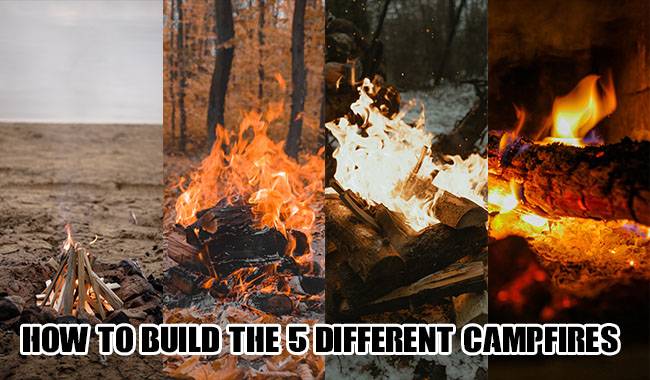
Campfires come in many different varieties, from the most basic to the exclusive variety used by campers who spend their winters in the forest without a tent. Each campfire is suited for a specific purpose. Some campfires are ideal for cooking, others for warmth, drying things out or cold overnight stays, and still others for large groups to hold outdoor gatherings. Recall that in some cases, building a fire may be difficult or prohibited, such as in a nature preserve. In such cases, you should bring a burner or a wood-burning stove. You will learn more about How to Build the 5 Different Campfires by LCNOutdoors article.
Firewood for Making a Fire
Before building a fire, you should stock up on firewood. Not all types of wood will burn, and sometimes firewood is not suitable for making a fire, cooking or heating. Some types of wood are hard and therefore difficult to saw, cut and light, and some do not burn well. Here we list the most common types of wood used for campfires in the United States.
- Oak is a good wood that burns very hot and for a long time. However, oak is difficult to cut and saw, and oak firewood does not burn easily.
- Birch – if it is not rotten – burns well, produces a lot of heat, and produces a good afterburner. Fresh, moist birch burns quite well because there is relatively little moisture in the wood during the summer, fall and winter months. Compared to oak, birch logs are easier to saw, chop and ignite. A huge advantage of birch is birch bark, which is the best natural kindling.
- Elm burns as well as birch, even when raw, but it does not cut or saw well.
- Alder firewood heats up quickly and produces a lot of heat. Alder firewood burns slowly, does not smoke, and produces the least amount of smoke. However, alder is only suitable for firewood if it is far from a body of water, and swampy alder does not make a good fire.
- Aspen and poplar are suitable for firewood only when there is no other choice. They do not burn easily and give off very little heat. But you can use poplar and aspen firewood to boil water or build a fire for snow. Willow, mountain ash and larch burn in a similar way.
- Pine trees are the best fuel for campfires. Pine trees can be found almost everywhere, and finding dry pine trees is usually not difficult. Dry pine burns very well, produces a slight spark, and hardly ever shoots. Pine is easy to saw, cut and ignite because its wood usually has gum in places that produce a hot flame, although there is smoke.
- Spruce also burns well, but it produces a lot of sparks and shoots out boiling resin. These sparks can easily burn holes in synthetic clothes and down jackets.
- For Campfires, fir is even more dangerous than spruce because it shoots out not just embers, but small burning fragments that can easily set your equipment on fire.
- Cedar is a good choice for firewood. It provides good heat and is easy to prick because of its soft wood.
5 Different Campfires
We have collected five of the most practical and effective Campfires for camping.
A. Teepee campfire
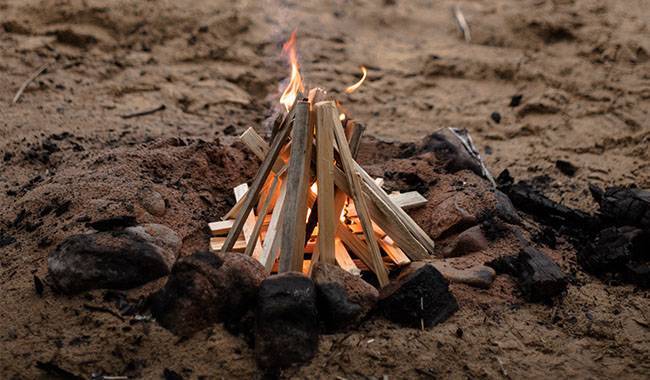
The Teepee campfire, which is also known as the tipi fire, tepee fire, and pyramid fire, clearly gets its range of names from its shape. The fire structure itself is one of the core 3 methods used to start fires or can be enlarged to be a fully functional fire in its own right.
Typically built for warmth or social reasons on a larger scale it can still be used for the purposes of cooking. The strong flames it creates are good for boiling in a gypsy, tripod or so similar suspended cooking method. After a time it also burns down well leaving a good bed of coals.
B. Log cabin campfire
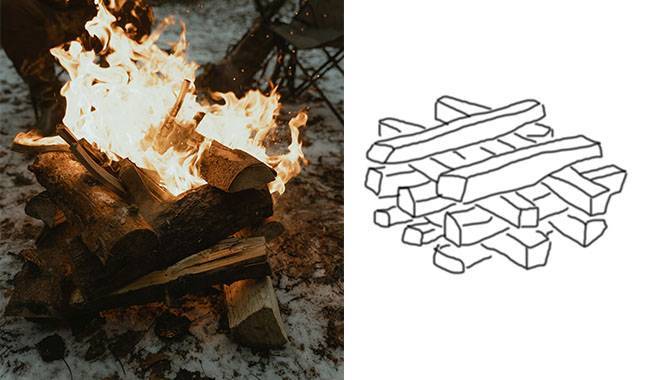
Many people have been familiar with the pioneer fire shelter, or “pioneer fire”, since childhood. It was easy to build and campers often used it, for example, during camping when they needed to make a quick fire from whatever they could find nearby – branches, sticks or logs. Such a fire provides so much heat and light that it is also used to light a large camp or as a signal fire.
A large number of coals consisting of burned wood were formed inside the hut, and these coals kept the heat inside the structure. Thus, even damp wood is well suited for a fire in the hut: the embers will dry out first and then start a fire. It has a large height, a wide and round base, and large gaps between the wood, so there is a good airflow inside the fire and enough oxygen for the fire to burn.
The ample air supply makes the fire in the hut so intense that its flames can rise to twice the height of the hut itself. Therefore such a fire should be handled with care, especially in windy weather. It is not recommended to keep it near a tent. You should also avoid drying your shoes, clothes and equipment too close to the fire: if the tent is burned, it may collapse and cover your belongings.
The flames of a shawl fire are high and hot, making it difficult to cook food. If you put a pot by the fire, it heats unevenly, and if you hang it over the fire, it’s inconvenient to stir the food. But there are plenty of hot ashes and coals on which to make stews and roast potatoes, meat and other foods. For simple cooking, it is best to build a hut and hang a pot on it.
A Log Cabin Fire is the most wood-intensive type of campfire. It burns out quickly and you have to keep adding more wood. Therefore, it is not suitable for sitting by the fire or sleeping overnight.
Generating Campfires is very easy. First, thin dry firewood branches are placed in the hut, and a second row of thicker sticks and branches are placed outside the hut to form a cone. Inside the cone are kindling – birch bark, dried needles, chaff, wood chips and other things. Firewood is lit, and as the flame grows, new firewood is stacked on top of the firewood already burning in the cone. Fuel should not be stacked too tightly, especially at the bottom, or the flow of oxygen to the center of the fire will be cut off.
C. Upside down (or pyramid) campfire
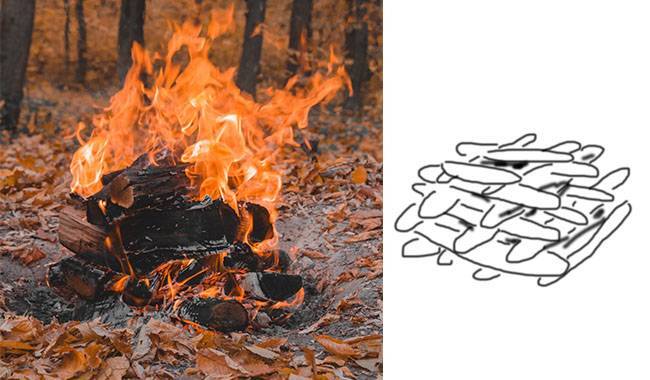
Campfires are probably the most versatile type of campfire. It burns longer than a shack and provides plenty of heat and coals, but it is also fairly low maintenance because it does not require constant tossing of wood.
A frying pan is perfect for cooking. You can hang the pan over the fire, place it on the embers in the center of the fire, or even place it on the wood that binds the sides of the fire. It’s also quite convenient to dry things and keep them warm with this structure.
To make a Campfires, you must first prepare 8-12 logs of approximately the same length to serve as the outline of the Campfires. Then a small log cabin must be built and lit, and the prepared logs are placed around the cabin in the form of a log cabin. When the wood is burned out, some firewood is placed to make the fire more flammable. The square billets – even if they are already damp – will dry out and catch fire fairly quickly. It is possible to dry out a lot of firewood on a well. Putting wet wood on it is enough to “build” it up. This creates a sort of chimney with a strong stream of hot air inside, which will dry the firewood.
Campfires have a variation where the wood is stacked tightly together with small gaps and the fire is lit on its upper platform. This fire burns evenly downward, maintaining a relatively even surface with a layer of coals. It’s harder to light because you need good, dry wood, and it doesn’t burn as well as traditional Campfires. But it’s handy for cooking. The flames don’t get too high and the kettle or pot can be placed directly on a flat wooded area.
D. A Nuotio Consisting of Three Pieces of Wood
The Three Log Node is a very comfortable, reliable and long lasting Campfires, perfect for long days out while camping in the winter. It burns for 6-8 hours, warms nicely along its entire length, gives off a nice soft light, requires no wood tossing, and is a lot of work to make. It’s easy to dry clothes and gear near a fire like this. If you build a simple shelter or wind screen with tents, polyethylene or spruce branches that reflect the heat of the fire and make a nice decoration, you can have a comfortable sleep next to Campfires even in frosty weather.
To make a triple noodle, you will need the following tools.
- saw;
- an axe.
- plenty of kindling – birch bark, dried pine branches, brushes, wood chips, etc;
- In order to quickly and evenly ignite the flame, it is best to use an air gun;
- something to fan the wind, such as a camping foam seat.
The first thing to do is to find a dead tree with dry firewood. Any species of tree will do, but a pine tree is the most suitable. A dead tree can be identified by the absence of needles and the remnants of leaves on the branches and tops of the tree. Do not use trees that have fallen to the ground: their wood is wetter. To keep your fire burning as long as possible, choose a dead tree with a trunk diameter of 12-15 inches (30-40 cm).
You should cut the selected tree with an axe or saw, cut off the branches, and split the trunk into three logs 6.5-8 inches (2-2.5 m) long. Ideally, have one or two extra logs on hand to replace the burned-out logs with new ones within a few hours.
The next step is to prepare for the fire. If there is a lot of snow, you should start by hoeing with skis or snowshoes and then place two or more poles at the edge of the future campfire, starting with the poles. Logs will be stacked on these poles. The poles can be of any kind – rotten, wet or ice – as long as they are not too thin.
All logs, including spares, should have a row of notches, or a slot cut along their entire length with an axe so they will burn better later.
Now you can start laying the logs on supports, or on the ground that has been cleared of snow. If you plan to build a reflective screen to spend the night next to your den, you will need to direct the heat from the fire to your future “bedroom”. To do this, place the thinnest of the three logs on one side of the sleeping area. Place the second log, the thickness of the middle one, close to the first one. Stack the logs in such a way that the joint surfaces of the two logs are at a small angle to each other. The logs can be held in place with stakes, poles or stones.
Place more kindling between the two logs along their entire length and light them in several places. It is convenient to use an air gun so that you can light the flames all the way around.
After a few minutes, when the kindling is on fire, place a third log on top of the two logs with the notch down. This log should be the thickest of the logs. The top log should be raised slightly at the edges with two plywood logs to make it catch fire better. This ensures a better airflow into the burning area. When all the firewood is burned and the fire has heated up, the spacers can be removed.
Place the spare logs close to the fire. You may need to replace burnt top logs during the night.
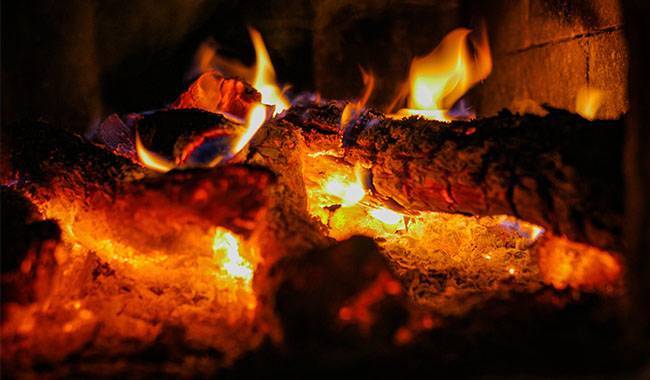
E. A Nuotio Consisting of Two Pieces of Wood
A nuotio made of two woods is a variant of the nuotio design. It can last five to six hours.
A two-wood nuotio is slightly more difficult to build than a three-wood nuotio. It has some disadvantages compared to previous versions: it doesn’t burn as long, has slightly less heat, is more labor-intensive, and is fussier. It is not safe to sleep in such a fireplace, because the logs will roll away. But it is comfortable to dry clothes and warm up next to a radiator made of two logs.
To build a classic hill you need a saw, an axe, two dry logs 6.5-8 inches (2-2.5 meters) long and 10-15 inches (25-40 cm) in diameter, some poles, and plenty of firewood. If the snow is very deep, you also need to plow the ground with an axe and then use poles or boards made from poles to plow the ground. Put a log on these poles and another one on top of it, leaving a gap with two pieces of wood at the edge of the cabin. The fire will be created in the gap. The structure should be secured at the edge with four poles.
Firewood is placed evenly between the logs along its entire length and ignited along its entire length. The fireplace is heated when the kindling burns out and turns into embers.
Be careful when you approach double wood Campfires: if the poles holding the fire are burned, the wood above may roll off the wood below. Therefore, it is not safe to sleep near such a fire
F. Finnish Candle
A Finnish candle (also known as a Swedish candle) is a fire made inside a vertically placed log or between several nailed logs set vertically. The candle can be used to cook food, boil water, and light campsites, but it cannot warm or dry clothes because its heat is directed upward, not sideways.
Finnish candles can be built in different ways. One way to make a candle is to build a fire inside a log and make several cuts. You must saw off a log 15-23 inches (40-60 cm) high, make 3-4 longitudinal cuts down the length of the log, put a sheet of birch bark in the middle, and light it. Cutting with a chainsaw is more effective than cutting with a hand hacksaw because it is the only way to make the cuts wide enough to ensure the necessary airflow to the flame in the center of the log. Such a candle burns very well and provides such powerful heat that the water boils almost faster than a gas cooking system. Another advantage of this type of fire is that it can be carried from one place to another.
Finnish sawtooth candles are great for winter camping and can be reached by car with a chainsaw or with ready-made logs.
Another option is a log candle that is divided into several parts. Candles of this design can be made with just an axe – no sawing required. You need to saw or cut a piece of wood from the log with an axe. In this case, the end face does not have to be flat, but it must be comfortable enough to fit the pot. You will then need to divide the log lengthwise into 4-6 sections and cut the core of each section with an axe to create a channel in the center of the log.
Next, you will need to join the sections together and pull them together at the bottom with string or wire. It is most convenient to attach a candle to another piece of wood and place small wood chips underneath the bottom to ensure that air flows into the burning area from below. Light the candle placed in the candle channel – birch bark, twigs, wood chips, dried needles – and light it. If the wood is dry, it will ignite quickly.
To make a Finnish candle using only an axe, you will need to divide the log lengthwise into 4-6 sections and cut the core of each section with an axe.
So Which Campfires are Best?
- It is convenient to use Campfires cabins when parking or when you need a big fire and bright lights.
- Firewalls are great for cooking when camping.
- Nuotio is good for cold overnight stays long gatherings with large companies, and drying items and equipment. Also, a Nuotio made of three logs is easier to arrange and burns longer than a Nuotio made of two logs.
- Finnish candle is perfect for cooking and boiling water in the campground.
We hope you have a nice, cozy night by the Campfires during your winter hike! Don’t be afraid to experiment and be sure to try building not only a simple fire but also a fire point and a Finnish candle. we are sure you will enjoy the process and the results.